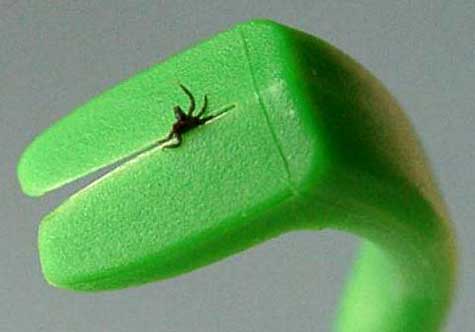- Symptoms of tick presence
- Places most exposed to bites
- Step mite removal plan
- What to do if the head remains
- What diseases do ticks suffer?
- Prevention
- How to detect a tick?
- How to protect an animal from pests?
- How to completely pull out a tick from a dog
- The second way to remove the tick from the dog's body
- Remains of a tick under the skin of an animal: what to do
- The saliva of the bloodsucker predator contains a kind of anesthesia, this explains why the bite is practically painless.
- In total on this world it is possible to count, in total about 48 thousand nothing.
- In their entire life, they barely crawl 10 meters, prefer not to chase the victim, and wait for her.
- In preparation for winter, the female lays eggs, hibernates, while the males do not live to spring.
- A female is slightly larger than a male 3-4 mm in length, but after sucking it grows to 10 mm.
- They do not like hot and dry weather, preferring shade and moisture.
- Apathy, lethargy.
- Red or dark, even black urine.
- Lack of appetite.
- Rapid breathing.
- Increased temperature - up to 41 degrees.
- Armpits.
- Groin area.
- Between the fingers.
- Behind the ears.
- Chin.
- It looks like a black dot, and you can pull it out just like a splinter, with the help of a needle, which you first need to ignite for disinfection.
- You can also try applying warm compresses to help the body reject the foreign object itself.
- If this was not possible, you should contact your veterinarian.
- Piroplasmosis. They tolerate ixodic mites, can occur both acutely and chronically. Mortally dangerous infection if it does not turn in time for medical help.
- Lyme disease. The symptoms are in many ways similar to the symptoms of the flu, can go on imperceptibly for up to 3.5 months and only then the disease manifests itself in the acute stage.
- Ehrlichiosis. The animal refuses to eat, the lymph nodes are often enlarged, possibly nosebleeds.
- Spray, drops and other special means. They should carefully treat the dog's coat and skin, starting from the end of March. These protective drugs have their own instructions, recommendations, contraindications for use. You should carefully study them, because for each age of the dog has its own range of tools.
- Collars. They are dressed in a pet just before the start of the walk. It is good to combine collars with drops, since in themselves they do not guarantee one hundred percent protection.
- tweezers, having necessarily a thick tip;
- in case of need a magnifying glass;
- alcohol as a disinfectant;
- all kinds of antiseptic agents;
- syringe;
- gloves (suitable latex, rubber);
- may need oil;
- additional lighting.
- it is very, very unpleasant, disgusting;
- so the person protects himself from possible infection.
Symptoms of tick presence
Of all 100% of arthropods, only 2% carry a serious danger.
In no case can one make a diagnosis on the basis of his observations. And to give drugs, especially since they are very toxic and you can harm even more.
Symptoms of infection (most common for our climate):
Places most exposed to bites

Step mite removal plan
Finding bloodsuckers need to act quickly:
There are other methods for removing unwanted and harmful guests. Alternatively, extraction using a thread:
Thickly smear mite with petroleum jelly, it will not be able to breathe and will fall off by itself. It is important not to miss this moment, otherwise the tick will bite the dog or someone from family members again.
If before unscrewing with tweezers, dripping sunflower or lube oil on a tick, it will go faster.
The most difficult thing, according to experienced dog breeders, is to hold the dog when it hurts. The procedure is not pleasant and you risk becoming bitten and scratched. Alone, you can hardly cope, you can't do without assistants. If you have a large copy, two are holding, one “operates”, calmly talking and stroking to minimize stress. After such violent treatment, you should be encouraged by a snack, making it clear that it was good, and next time not to pull the patient out from under the couch.
What to do if the head remains
If you were unable to completely remove the tick, and the head still remained in the body of the dog, you do not need to panic. It is necessary to get it so that the infection does not continue:
Necessary measures after the procedure:
After that, it remains to wait and hope that health dog is coming on the amendment or not deteriorating. If, however, you suspect something is wrong, be sure to pass an examination. Infections that the tick can tolerate are very dangerous and some are even deadly. 
What diseases do ticks suffer?
Ticks can carry and transmit a whole bunch, making it difficult to work diagnostics.
Prevention

There are a number of rules on how to pull a dog tick. They can not be neglected, because getting rid of the pest is a serious and responsible process. So in the case of careless pulling along the axis, the proboscis will come off and forever stick to the pet's body. To remove an insect, do not squeeze its body or tear it apart. This can lead to the discharge of infectious pathogens or inflammation.
How to detect a tick?
Ticks are famous for their agility, and therefore it is necessary to remove them from the body of the animal very quickly. On short-haired dogs it is easier to recognize the enemy, in view of the greater visibility. The pincers are quite small in size (up to half a centimeter), with a shield on the back. Before the start of his meal, the color of the insect is brown or black, but after penetration it resembles a dirty yellow or pink pea. Especially carefully should inspect places with thin skin: the base of the skull, abdominal area, ears. When palpating, it is important to move against the fur of the animal, which will help to detect ticks that have already settled down. Inspection is carried out in gloves due to compliance with personal safety measures.
How to protect an animal from pests?
Absolute protection for your pet is impossible to provide. This issue should be approached comprehensively, given the available methods of caution:
If you still cannot remove the tick yourself, or the condition of the dog has deteriorated, you should immediately contact your veterinarian for help.
So, here we should highlight such tools:
Having prepared all the components that were listed above, you can begin the procedure for removing a tick from a dog.
How to completely pull out a tick from a dog
 Experts recommend reassuring the pet before starting the removal procedure. Otherwise, it is recommended to call someone as an extra hand in order to be able to confidently hold the dog.
Experts recommend reassuring the pet before starting the removal procedure. Otherwise, it is recommended to call someone as an extra hand in order to be able to confidently hold the dog.
It is imperative that the chosen tool for removal must be thoroughly disinfected with alcohol or, if it is a metal device, then calcined for a minute or two above the fire.
It is strongly recommended to carry out the removal of the insect with gloves, because it is better not to contact directly with the pest:
The next step is to remove the hair from the area of the bite, after which the tweezers must be positioned so that its tips could clamp the tick as close as possible to the proboscis. It is worth knowing that under no circumstances should the tick be wrapped around the abdomen. Now a slow movement without significant jerks should pull the insect up. In this procedure, it is necessary to exclude any sharp movements, otherwise you can tear off the abdomen and, accordingly, leave the head under the skin.
What to do next with a tick bite from a dog? It is carefully disinfected using alcohol or washed with a soap solution prepared in advance on the basis of laundry soap (required!). In order to speed up the healing process of the dog's wound, experts recommend treating it with an antiseptic.
When the worst is over, you should definitely check the animal for the presence of other ticks. Particular attention should be paid to the stomach, neck, face, interdigital area on all legs, ears (sometimes they can "look" directly from the ear).
The second way to remove the tick from the dog's body
This method is simpler, faster and at the same time quite effective. Fingers need to be carefully, without squeezing the body of the tick, you need to quickly rotate the insect - this is similar to the usual rubbing with your fingers. This kind of action does not like the tick, and he independently begins to try to get out. With proper execution of the insect removal technique, the risk of a head residue in the dog’s body becomes negligible.
You need to understand that from the first time this method may not work, and it is precisely this fear that will crush the disgusting insect. The method, of course, is much more unpleasant than using tweezers, but more effective. On the Internet you can find a lot of videos where the removal of a tick with similar circular movements with your fingers is clearly demonstrated.
Remains of a tick under the skin of an animal: what to do
 It is not excluded that situations in which even a correct action can leave a part of the pest under the skin of a dog. In this case, it is urgently recommended to seek professional help from a veterinarian. However, if there is no such possibility, then the experts recommend to independently engage in the extraction of residues using a needle that was previously disinfected. Removal should be similar to the usual elimination of splinters.
It is not excluded that situations in which even a correct action can leave a part of the pest under the skin of a dog. In this case, it is urgently recommended to seek professional help from a veterinarian. However, if there is no such possibility, then the experts recommend to independently engage in the extraction of residues using a needle that was previously disinfected. Removal should be similar to the usual elimination of splinters.
It is important to remember here that such a method will certainly be painful enough for an animal and does not exclude the risk of infection in an open wound.
Despite the fact that in the city most people have dogs in their apartments, animals have a rather big chance to pick up a tick. It’s not the fact that the tick bites the animal, but the fact that the owners do not know the dog and what to do after that is scary.
How to safely remove the tick. Method number 1
Method number 2
If you do not know the dog is safe, then this method is for you. Take a needle and glow it on the plate (hold the needle with pliers or other object at hand to avoid getting burned), then stick the needle into the body of the tick. Be careful not to burn the dog. Hold the needle for some time in an insect, then remove the tick as in the previous method.
Method number 3
Basic and necessary rules during tick removal
It’s not enough to know how to get a dog out of a tick, you also need to know what precautions to take.
Precautions and Prevention
First, in early spring, buy a dog collar that protects against ticks. Additionally, you can drip on the withers pet special tool.
Thirdly, at the peak of the spread of such ticks, try to avoid walking in the woods, in the tall grass, etc.
What to do after tick removal
If you are not confident in your abilities and do not know the dog, go to the nearest veterinary clinic. There, the animal will provide the necessary assistance.
If it was not possible to avoid the tick bite, do not worry and do not be nervous. Gather and quietly remove the insect. If necessary, consult a professional. The main thing - in time to take the necessary measures, and your dog will feel great.
Avid dog lovers or simply owners of shaggy friends often wonder: how to get a tick out of a dog. Noticing the insect on the skin of a pet, the owners immediately try to save the dog from trouble. Improper actions can lead to negative consequences, prolonged illness of the pet.
The faster to detect a tick, a bite, the less likely it is to infect with various diseases of the dog. It is quite possible to extract the tick at home, the main thing is to do it carefully and without sudden movements.
What diseases do ticks suffer?
How to detect a tick?
How to protect an animal from pests?
What to do next with a tick bite from a dog?





